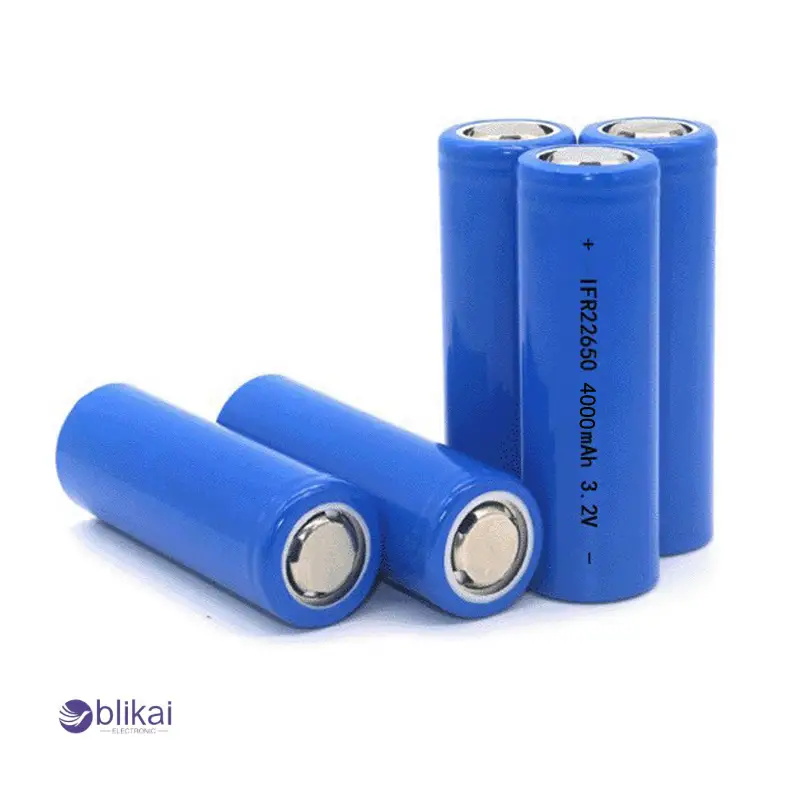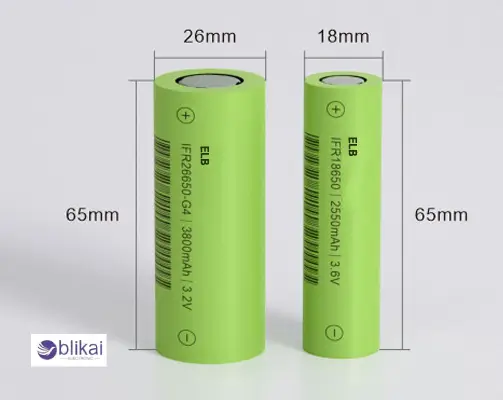26650 Battery vs 18650 Battery: Key Differences
Introduction
Lithium-ion batteries are now the focus of the new mobile technology. There exist two common variations of lithium-ion batteries and that is, namely the 26650 battery and also 18650 battery, for different applications. This renders the comparison of the two very relevant to any individual who wants to select the correct battery to use in a particular application.
What is a 26650 Battery?
A 26650-type battery is one of the types of lithium-ion cylindrical batteries that have become popular in applications that require massive energy storage and excellent discharge characteristics. The numbers of its physical dimensions define the 26650 in its name. 26650 cells measure 26 millimeters wide and 65 millimeters long. They can offer greater capacity, higher performance, as well as stability during high load conditions, and have a larger space to accommodate active materials.

What is an 18650 Battery?
The most widespread type of lithium-ion cells is the 18650 lithium-ion cells, which are known as 18 millimeters in diameter and 65 millimeters in length. Their low dimensions enable weight saving and portability when used as consumer electronics due to their optimal portability, speed, and energy density. In the long run, 18650 cells have achieved the status of relatively inexpensive so-called standard cells, and they are in wide use on a mass scale, and are very compatible with many industries anywhere on Earth.
Major Differences 26650 Battery and the 18650 Battery
Size and Dimensions
The weight and size is one difference between 18650 and 26650 which is one of the greatest. The battery of diameter 26650 and length 65mm is bigger in size, and the 18650 battery is smaller, 18mm and 65mm. This contributes to the bulkiness and increased weight of the 26650 battery, so that only smaller devices can be used. But the bigger dimensions allow for the extra space for active materials, which eventually results in greater capacity and effectiveness.
Capacity and Runtime
Having usual ratings of 4000mAh to 6000mAh, its long life to run is more efficient as compared to the 18650 model, which has an average life to run of about 3500mAh. The devices powered by 26650 cells can be operated longer, and the devices need not be recharged often, like the powerful flashlight that is powered by 26650 cells will last longer on a single charge than one that uses 18650. The higher power is what makes it a good choice, given the fact that it is needed in those cases when one requires longer periods of use, like those applications that involve endurance and heavy-duty performance, where the running time performance is a must.
Discharge Rate and Power Output
As far as discharge rate and power output are concerned, both batteries are doing well, although the 26650 battery tends to achieve better results at heavy loads. The 26650's increased interior design allows it to accommodate greater internal current draws without overheating or experiencing significant voltage loss, making it suitable for devices such as power tools or e-bikes requiring bursts of power, such as burst grinders. Meanwhile, it has a moderate load range, such that the 18650 is the default selection on laptops, vaping devices and other smaller electronics, and the 26650 is the default selection in high-drain cases, but the 18650 should then be used more frequently in everyday cases.
Compatibility
Lastly, compatibility is also a good factor to consider in an evaluation between a 26650 and 18650 battery. The 18650 is over 10 years old and is a standard for a variety of devices, including flashlights, as well as laptops. There is also a greater availability of matching chargers and equipment. The 26650 is not quite as common as it is becoming increasingly popular; thus, users should be mindful that their gadgets have actually been designed to suit the bigger cellular device. With that said, numerous flashlight, e-bike, and power tool manufacturers have begun incorporating designs that are 26650-friendly so that they can utilize the increased capacity. In brief, the 18650 is more popular than the 26650. which is popular amongst those who require advanced high-capacity applications.

Disadvantages of the 26650 Battery
Larger Size and Heavier Weight
It is quite large: 26mm in diameter and 65mm long, which is significantly larger than the 18650. and thus can not be used in compact or lightweight devices. This may be a drawback to the user who values portability, whereby carrying one or two 26650 cells may be an unnecessary additional weight. The additional mass can also restrict its application with drones, laptops and other products where the design efficiency is based on having the total form factor as light and compact as possible.
Limited Compatibility and Availability
The other con with the type of battery is that the 26650 battery is relatively incompatible with other, more common batteries like the 18650. Although most flashlights, e-bikes and specialty tools are constructed to accept 26650 cells, most consumer electronics are designed using the 18650 standard. It also implies that fewer chargers and replacement cells or aftermarket accessories will be readily available to users. Also, since the 26650 is manufactured in smaller and larger quantities than the 18650. it may have higher prices and be of limited supply. The 26650 might not necessarily be the most feasible option in the case of people who need universal compatibility and easy sourcing.
Disadvantages of the 18650 Battery
Lower Capacity Compared to Larger Cells
18650 batteries have low capacity, 2000mAh to 3500mAh usually their major problem. They contain significantly less power than bigger cells, such as 26650. and they could require more frequent rejuvenation on the occasions they cater to devices that consume a lot of power, like flashlights, e-bikes or power tools.
Limited Performance Under Heavy Loads
The other disadvantage of the 18650 battery is its performance in the case of heavy loads. Although it can reliably support mild current draws, sustained high-drain may load the battery nearer to its maximum, leading to voltage drop or lowering efficiency. The 18650 may not perform as well in a device that needs high-speed bursts of power (power tools) or needs high power output (some electric vehicles) as a 26650. The smaller cell might not service the needs of the users who depend on a high-current operation and may also need long-duration operation.
Shorter Lifespan in High-Drain Applications
The 18650 batteries may also have their life span affected by high-drain usage. Recurring deep discharges or subjecting them to high currents may increase the rate at which capacities are destroyed with time, and thus the number of effective charge discharges may be reduced. Although the 18650 cells are considered to be good in moderate use, they are limited in their effective lifespan by heavy loads. This is particularly true with those users who habitually have to use their gadgets over a considerable amount of time because it might require them to change their batteries more often at the expense and inconvenience. Conversely, bigger cells such as the 26650 can be reputedly graciously accommodative to high-drain conditions.
Lower Absolute Energy Storage
Lastly, the size of the 18650 battery automatically places a limit on its total power hold. Although it has a good energy density when compared to its volume, it does not compare to the absolute capacity of a 26650 cell. This may be a drawback in a scenario where a long run time is a must, such as emergency lights, long-distance e-bike rides or long outdoor engagements. The 18650 may not be sufficient to offer maximum energy capacity to the user who does not require any additional battery pack. It is a good size that fits in portable electronics, but in terms of high-endurance applications, it usually cannot compete with larger cylindrical cells.
Which One Should You Choose?
When to Choose a 26650 Battery
The 26650 battery will be the most suitable one in areas where it is necessary to emphasize high capacity, long working time, and powerful discharge performance. High-output flashlights, e-bikes, and heavy-duty power tools are the devices that may greatly benefit from the increased energy storage, as well as the capacity to be powered by a large current. Examples of such benefits include the outdoor enthusiasts who will enjoy a flashlight, which is powered by a 26650 and can last the entire night without being recharged or an e-bike that can cover more distance without needing to recharge. The 26650 is an offered easy weight and thus often needed when the stability and the trustworthiness of the device are of the utmost importance.
When to Choose an 18650 Battery
Smaller-sized Laptops, vaping devices and flashlights tend to carry 18650 batteries as these are powerful enough, but are light and easy to carry. Customers wishing for convenience, best economical and quicker replacement generally purchase smaller batteries; however, these are less capacitive because of their size, and, thus, because of such low capacity, the recharging process becomes easier.
Conclusion
Both 26650 and 18650 batteries play a pivotal yet distinct role in modern devices. Choosing between either option ultimately comes down to your device requirements, usage patterns and priorities - either option could maximize endurance vs maximize space and accessibility with a 26650 battery vs 18650 battery.
FAQ
1. Is it possible to operate a 26650 battery in devices made for 18650 batteries?
No. The 26650 is also larger and cannot fit in the 18650 slots. Any force can be used to break the device or the battery. However, safety and good performance all the time would require you to use batteries that are always compatible with your device.
2. Which one has a longer service life, the 26650 or the 18650 battery?
This is what makes the 26650 a long-life one compared to the small one due to its large capacity (4000-6000mAh) compared to the small one (18650 up to 3500mAh). It is suited to strongly-draining devices. The 18650 will suit smaller electronic devices and a shorter run duration.
3. Are 26650 batteries more expensive than 18650 batteries?
Yes. The size, capacity and smaller production lots elicit the difference in prices of the 26650 batteries. The 18650 is less expensive to obtain, far more universal and adequate for most of the small devices.
Some images are sourced online. Please contact us for removal if any copyright concerns arise.
EFB Battery vs. AGM Battery: Comparing the Differences
Dry Cell Battery vs Wet Cell Battery: Differences
NiCd Battery vs NiMH Battery: Differences
Boat Battery: Types, Chemistry & How to Choose
Battery Isolator Explained: Functions, Types & How to Choose
UPS Battery Guide: Types, Lifespan, Replacement & Safety Tips
2 Gauge Battery Cable: Applications, Features & Comparisons
C Battery vs AA, AAA, D & 9V Battery: Differences
6V Battery vs 12V Battery: Features, Applications & Performance
Automotive Battery Guide: 24F Battery vs 27F Battery Explained










